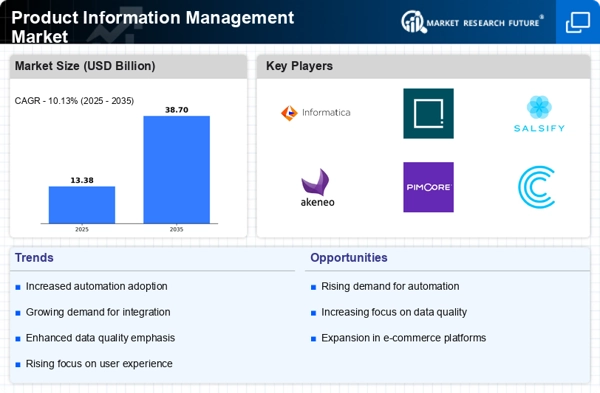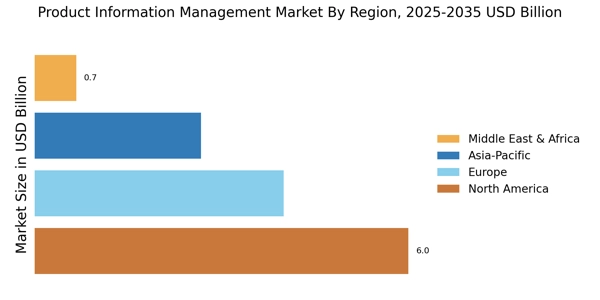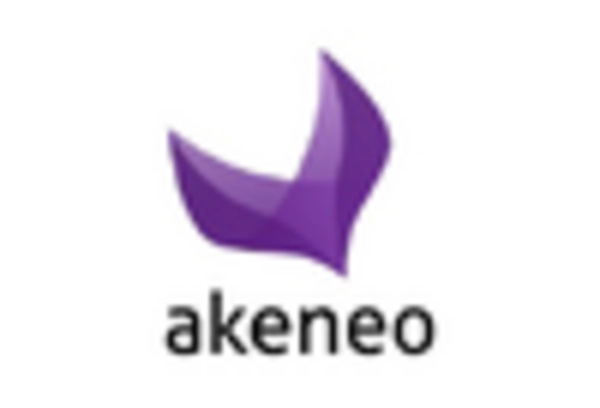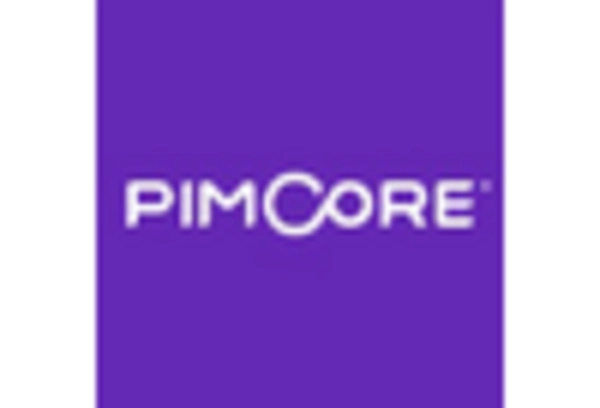Expansion of E-commerce Platforms
The Product Information Management Market is significantly influenced by the rapid expansion of e-commerce platforms. As more businesses transition to online sales channels, the need for effective product information management becomes paramount. E-commerce platforms require accurate, detailed, and consistent product data to attract and retain customers. Recent statistics indicate that e-commerce sales are expected to reach trillions of dollars in the next few years, underscoring the urgency for businesses to implement PIM solutions. These systems enable organizations to manage vast amounts of product information efficiently, ensuring that customers receive the correct details at every touchpoint. This trend is likely to drive further growth in the PIM market as companies seek to optimize their online presence.
Growing Importance of Data Governance
In the Product Information Management Market, the emphasis on data governance is becoming increasingly critical. Organizations are recognizing that effective data management practices are essential for maintaining data integrity and compliance with regulations. The rise of data privacy laws and standards has prompted companies to adopt stringent data governance frameworks. This shift is reflected in the market, where the demand for PIM solutions that offer robust data governance features is on the rise. It is estimated that organizations with strong data governance practices can reduce data-related risks by up to 30%, thereby enhancing their operational efficiency and decision-making capabilities. Consequently, businesses are prioritizing investments in PIM systems that facilitate comprehensive data governance.
Increased Focus on Customer Experience
The Product Information Management Market is witnessing a heightened focus on enhancing customer experience. Companies are increasingly aware that providing accurate and comprehensive product information is crucial for customer satisfaction. As consumers become more discerning, they expect detailed product descriptions, specifications, and images before making purchasing decisions. This shift is prompting businesses to invest in PIM solutions that streamline the management of product data across various channels. Research indicates that organizations that prioritize customer experience can achieve higher conversion rates and customer retention. Therefore, the demand for PIM systems that facilitate a superior customer experience is likely to continue growing, as companies strive to meet evolving consumer expectations.
Rising Demand for Omnichannel Retailing
The Product Information Management Market is experiencing a notable surge in demand for omnichannel retailing strategies. Retailers are increasingly recognizing the necessity of providing a seamless customer experience across various platforms, including online, mobile, and in-store. This trend is driven by consumer expectations for consistent product information and availability, which necessitates robust product information management systems. According to recent data, the omnichannel retail market is projected to grow significantly, with estimates suggesting a compound annual growth rate of over 20% in the coming years. As a result, businesses are investing in PIM solutions to ensure accurate and synchronized product data across all channels, thereby enhancing customer satisfaction and loyalty.
Technological Advancements in PIM Solutions
The Product Information Management Market is being propelled by rapid technological advancements in PIM solutions. Innovations such as artificial intelligence, machine learning, and automation are transforming how businesses manage product information. These technologies enable organizations to automate data entry, enhance data accuracy, and improve the overall efficiency of product information workflows. As a result, companies are increasingly adopting advanced PIM systems to stay competitive in a fast-paced market. Market analysis suggests that the integration of AI-driven features in PIM solutions can lead to significant time savings and reduced operational costs. This trend indicates a strong potential for growth in the PIM market as businesses seek to leverage technology to optimize their product information management processes.


















Leave a Comment